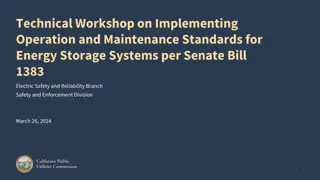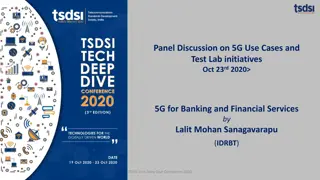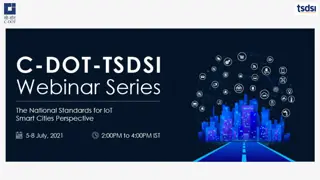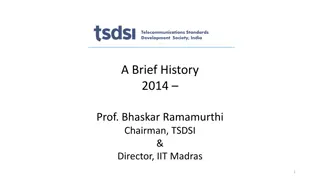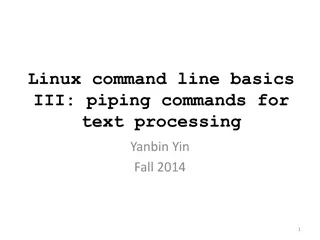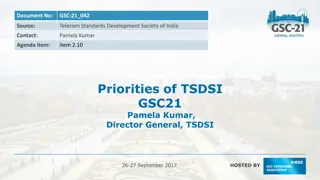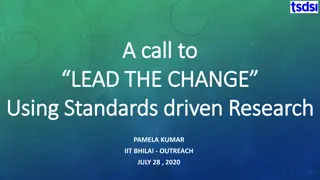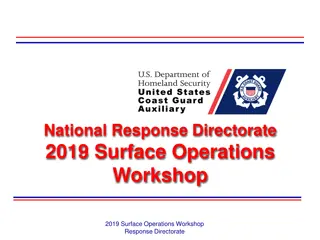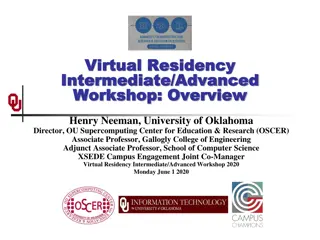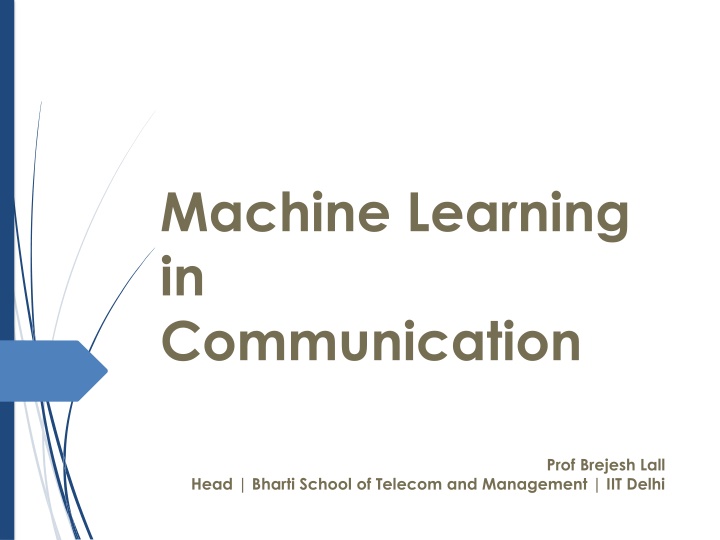
Machine Learning Applications in 5G Communication Networks
Explore the integration of machine learning in 5G communication networks, including its role in optimization, deep learning applications, and potential benefits. Learn about ML techniques, activities at IIT Delhi, and the significance of AI in enhancing network functionalities and predictive analysis.
Download Presentation

Please find below an Image/Link to download the presentation.
The content on the website is provided AS IS for your information and personal use only. It may not be sold, licensed, or shared on other websites without obtaining consent from the author. If you encounter any issues during the download, it is possible that the publisher has removed the file from their server.
You are allowed to download the files provided on this website for personal or commercial use, subject to the condition that they are used lawfully. All files are the property of their respective owners.
The content on the website is provided AS IS for your information and personal use only. It may not be sold, licensed, or shared on other websites without obtaining consent from the author.
E N D
Presentation Transcript
Machine Learning in Communication Prof Brejesh Lall Head | Bharti School of Telecom and Management | IIT Delhi
Agenda About 5G ML in 5G Why? ML Techniques ML Activities at IIT Delhi Compressed and Performance Optimized Deep Transfer Learning for 5G and beyond Deep Learning Based Tuberculosis from Indian Chest X-ray Images Two-Stage Unsupervised Deep Framework Data-driven Sensing for Action Recognition using Deep Convolutional Neural Networks Standardization Take away points Automated Diagnosis of
About 5G All about computing and communication Seamless and ubiquitous connections Diverse application support: eMBB, UrLLc, mMTC Numerous supporting technologies Not a piece of cake
Machine Learning in 5G For optimization ML to play Key roles in channel estimation Localization PAPR reduction Power control Interference control Compute and storage optimization identification, adaptation, prediction and
Why? Potential benefits: Enables coping with the massive connectivity in the 5G and beyond 5G networks, by diminishing the mismatch between reality and complexities Supports reduction in the count of the measurements, and facilitates robust decision making Facilitates self-organizing networks Supports robust predictive analysis, in terms of robust QoS predictions, anticipatory networking Better tracking abilities models, thereby reducing
ML Techniques Reinforcement Learning Goal achievement through experience Actions performed for reward maximization Factors impacting RL techniques: State transition model, and action policy Deep Learning Basis-Artificial neural network Learning and recognition of patterns Learning classified as supervised, semi-supervised or unsupervised
ML Activities at IIT Delhi Model Compression Healthcare Convolutional Neural Networks Deep Learning SLAM and human pose detection Standardization
Compressed and Performance Optimized Deep Transfer Learning for 5G and beyond Current state of art: Parameter pruning and sharing Low-rank factorization Transferred/compact convolutional Knowledge distillation Non-parametric approaches (often hybrid of Transferred and knowledge distillation) Proposed Design aims to introduce a function orchestrator which will: choose the best of art for each application and compress that pre-trained model to achieve high accuracy at low compute and storage making it compatible with hand-held devices and thus further enabling 5G.
Deep Learning Based Automated Diagnosis of Tuberculosis from Indian Chest X-ray Images The Problem: Tuberculosis (TB) is one of the most serious chest disease and leading cause of death worldwide. Automatic diagnosis of TB holds vast potential to assist medical experts to improve this health-care situation especially in developing countries like India where there is shortage of trained medical experts. The methods reported in the literature does not perform well on Indian chest X-ray images. The proposed work, under CRDF project, aims to explore the performance of Convolutional neural networks (CNNs) for identification and visualization of TB Symptoms from Indian chest x-ray images. The Methodology: Pre-trained CNNs AlexNet, GoogLenet and ResNet were used to classify chest x-ray image into two class: healthy or TB. Incremental training on Indian chest x-ray & Data Augmentation Classification Results: Neural Network Sensitivity (in %) Specificity (in %) Accuracy (in %) AlexNet 98.60 83.30 91.18 GoogLenet 92.90 84.80 88.97 ResNet 18 98.60 87.87 93.38 ResNet 50 90.00 92.42 91.18 ResNet 101 92.90 93.93 93.40 Chest x-ray of a TB patient (left image), Detected abnormalities (pink color) by NN(right image)
Air Pollution Monitoring Using Sensor Networks Objective: A high spatial and temporal resolution of air quality data will help in achieving correct correlation between pollutant concentration and their health impacts. It will help civic authorities in implementing control measures. Future Work: Identifying optimal locations for sensor deployment Increasing the reliability of the sensor network Calibration of sensors Data Analytics on Air pollution Data
Computer aided diagnosis system for brain tumor analysis A tumor refers to the uncontrolled growth of cells in solid tissues such as bone, muscle or organ. In 2016, 330000 cases of CNS (Central Nervous System) cancer and 227000 deaths are reported worldwide. Deep learning techniques are employed in this field, however efficient technique for automatic diagnosis of tumor is required for timely treatment of disease. The numerous deep learning techniques are tested on BraTS 2018- 2019 database and testing is done on the Fortis dataset.
Two-Stage Unsupervised Deep Framework 3D Structure recovery is possible with a single image (Single view depth estimation) Two-stage deep framework - Pyramidal Input used to learn depth at 4 scales, utilizing depth super resolution Warp errors, reconstructed images, predicted depth and original left input to refine the depth predicted by the first stage Photo consistency utilized for imposing, occlusion, left right consistency and disparity smoothness constraints for learning monocular depth
Data-driven Sensing for Action Recognition using Deep Convolutional Neural Networks The Methodology includes: Video Sequence Encoder Classifier Output
Blind Channel Coding Identification using Neural Networks We aim to identify the channel parameters of RS and Convolution encoder from a candidate set using the pattern recognition properties of an Artificial Neural Network (ANN) without any prior knowledge of the received signal. A supervised Multi-Layer Perceptron (MLP) with one hidden layer has been used. Training data is fed backpropagation is applied at every iteration during training Over a few series of epochs the network is able to distinguish between different encoders and classify them. to the network and
Standardization The design of the evolving 5G networks is stretching all the boundaries, while conforming to the rapidly changing standards of wireless communication. Standardization activities undertaken by various organizations. These include: ITU (FGML5G) 3GPP ETSI IETF MPEG
Take away points ML will cope with the rising complexity levels in the 5G networks There is a need for robust online ML methods, to effectively exploit the domain knowledge, and feature learning Low latency implementation using GPUs supports massive parallelization


